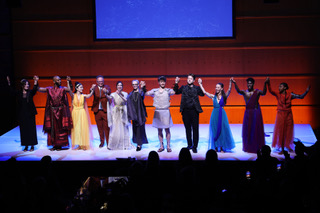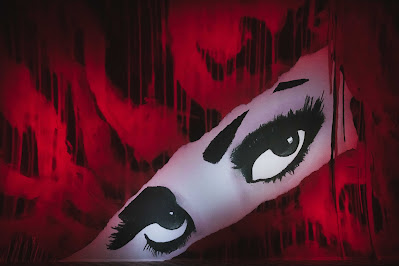.jpg) |
| Carlis Shane Clark as Agamemnon leads the guests in a procession from California Scenario to the Samueli Theater. |
REVIEW
Long Beach Opera, Segerstrom Center for the Arts, Costa Mesa
RODNEY PUNT
Artistic director James Darrah and his merry band at the Long Beach Opera continue to innovate productions that wake up eyes and shake up ears in novel ways. One of its most ambitious efforts just visited Orange County with a light-hearted, multi-dimensional operatic happening that was part spectacle, part cuisine, and part post-dinner opera as entertainment.
Darrah inherited this company not so long ago with its modus operandi to produce clever shows on the cheap. His personal stamp on the virtues and challenges of this approach were on full display in an ambitious al fresco production last June of Handel’s Giustino (reviewed here), where one shivered and squinted a bit to take in a rollicking show on the patio of the city’s Museum of Latin American Art. That was followed in February with less flair in the musty-funky production of The Romance of the Rose, by Kate Soper, at San Pedro’s decrepit Warner Grand Theatre. (Heads up: renovation is planned from 2024.)
In a surprising and welcome upgrade, the LBO’s latest production, a mash-up of Classical Antiquity called "The Feast," pulled out all the stops in collaboration with Orange County's upscale Segerstrom Center for the Arts in Costa Mesa. Two of its tony venues bookended an indoor-outdoor, three-dimensional, multi-discipline extravaganza that lived up to its promise of “a glorious, decadent, immersive experience.” The show was organized in two parts, the first at an outside space, the second inside a splendid performance hall I had not visited before.
.jpg) |
| Lloyd Knight as Medea in the California Scenario Noguchi Garden. |
Wandering the park at leisure, patrons took in its enchanted nooks and crannies, encountered archaic-costumed characters in stagey poses who would appear again on a more formal interior stage later: Agamemnon (actor Carlis Shane Clark) and four dancers of the Martha Graham Dance Company costumed as Clytemnestra (Xin Ying), Medea (Lloyd Knight), Theseus (Leslie Andrea Williams), and Cassandra of Troy (Anne Souder).
Athletic and contortionist, the light-as-air dancers (choreographed this evening by Janet Eilber) filled the space with kinetic movement, tableaux on mounting protruding rocks, leaping over the riverbeds that crisscross the garden.
PART II -- At 8 pm the five above cast members guided the audience of 180 along a path and across the street to the Samueli Theater, where they would be seated snugly at long tables for what was dubbed a “world premiere reinvention of a baroque banquet inspired by George Frideric Handel’s opera Alessandro.” After an hour consuming a delectable meal of duck, wine, and Läderach chocolate, at 9 pm an hour and a quarter of Handelian entertainment ensued.
 |
| Handel in the late 1720s, at the height of his career as an opera composer. |
Where Darrah’s earlier Giustino production had stayed within the confines of that one work, he went for broke on this occasion, cleverly pilfering and stitching together 16 glinting-diamond arias, instrumentals, and duets from other rarely performed Handel operas. Darrah had solid precedent for this. Handel was his own flagrant poacher and re-user whenever he felt the need to borrow from the 42 operas he composed before switching to oratorios late in his career, some purloined numbers even making their way into the latter.
At the first sound of the instrumentalists, an immediate aural impression struck all present: the house acoustics of the Samueli were superb. There was no need for orchestral amplification, nor would there later be any body miking of the singers. All instrumental and vocal sonorities were gloriously acoustic, unadulterated by distorting electronic amplification. This proved an aural revelation.
.jpg) |
| Xin Ying as Clytemnestra. |
The four returning dancers, in their guises as Clytemnestra, Medea, Theseus, and Cassandra, would enliven the room with graceful three-dimensional atmospherics for the rest of the evening.
.jpg) |
| Anna Souder as Cassandra. |
Competitive energy between the two singers being the essence of the Handelian atmospherics to follow, Schubert and Orliński delivered a pastiche of Handel’s greatest operatic hits. It would eventually take on the cheeky feel of "Anything you can do I can do better." In the 10 solo arias (five each) and two duets, to follow, the two explored a range of emotional states, including aggression, love, loss, ambition, and indulgence.
Screen projections of lyric translations were only partially useful, as the texts seemed too generic to illuminate any sort of plot. And when dancers and singers simultaneously moved around on and off the stage, there was scant time to turn one’s head back to a screen to read. It was best to just surrender to the exuberant moments of three-dimensional theater.
.jpg) |
| Jakub Jozef Orlinski, center, as Alexander the Great. |
Superstar Jakub Józef Orliński brought charisma to his half of the vocal program. Eschewing the precious falsetto projections of yesteryear’s English countertenors, Orliński delivered authentic full-voiced heroics to his five arias, one each from Tolomeo, Riccardo, and Amadigi, and two from Agrippina. It was pure pleasure hearing this singer at the peak of his powers, subduing the by-now partially inebriated audience into an awed silence of appreciation for such an exceptional talent.
Partnering Orliński was the LBO’s prominent in-house soprano, the crystalline-voiced Anna Schubert. But would his powerful virtuosity overwhelm her dramatically? I might have been concerned about that had I not seen Schubert’s performance in last July's Giustino. Her role there had been the journey of an initially inexperienced queen who faces down dangerous challenges to her authority by subduing macho males. Schubert's voice was amplified on that occasion (as were all the other singers in the al fresco setting). But how would she compare in tonight's interior acoustic setting pairing with Orliński powerful projection?
.jpg) |
| Anna Schubert as Cleopatra. |
In the event, one needn’t have worried. In her five solo arias (from Giulio Cesare, Teseo, Trionfo del Tempo and two from Alessandro), Schubert had enough high-octane vocal prowess to match Orliński, not so much in raw power as in how the ring of her tonal focus carried across the room into welcoming ears. (Wherever Schubert's vocal coaches are, past and present, blessings be upon you.)
Two duets from Serse and Alessandro confirmed the wisdom of pairing Orliński and Schubert, who have both achieved early peaks in their careers. If the solos and duets had been taken as entries in an antiquarian singing contest between them, the result would have been a draw, a great credit to both singers. It was a match made in Handel Heaven. That said, the single most exciting vocal moment had to be Schubert’s nailing a climactic high D on the last note of “Piangerò la sorte mia” from Giulio Cesare in Egitto. It alighted with the awe-inspiring elegance of a NASA moon landing. And the audience was just as over the moon as she was.
Later in the banquet’s musical entertainment, as if the evening had not contained enough disparate events and surprises, the theatrical “fourth wall” was broken in the Samueli when singers and cast members suddenly descended and scampered like church mice along the sides of the hall for more ceremonial doings, in some cases involving audience members at the head table in the middle.
Breaking barriers and innovating surprises have long been LBO specialties. This mash-up of Ancient World icons, like those Clash of the Titans movies, may not have been the company's most dramatically focused, but it was certainly one of its most successful experiments. And, by the way, the Samueli Theater at Segerstrom should become a regular venue for future productions of this fine company.
---ooo---
Long Beach Opera at California Scenario and the Samueli Theater, Segerstrom Center for the Arts, Sunday, May 21, 2023, 7:00 p.m. / 8:00 p.m.
Images: The production: Philip Faraone, Getty Images; Handel: Wikimedia Commons.





.jpg)































